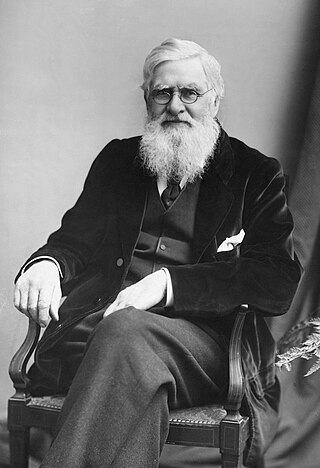
Alfred Russel Wallace was an English naturalist, explorer, geographer, anthropologist, biologist and illustrator. He independently conceived the theory of evolution through natural selection; his 1858 paper on the subject was published that year alongside extracts from Charles Darwin's earlier writings on the topic. It spurred Darwin to set aside the "big species book" he was drafting and quickly write an abstract of it, which was published in 1859 as On the Origin of Species.

Darwinism is a theory of biological evolution developed by the English naturalist Charles Darwin (1809–1882) and others, stating that all species of organisms arise and develop through the natural selection of small, inherited variations that increase the individual's ability to compete, survive, and reproduce. Also called Darwinian theory, it originally included the broad concepts of transmutation of species or of evolution which gained general scientific acceptance after Darwin published On the Origin of Species in 1859, including concepts which predated Darwin's theories. English biologist Thomas Henry Huxley coined the term Darwinism in April 1860.

Natural selection is the differential survival and reproduction of individuals due to differences in phenotype. It is a key mechanism of evolution, the change in the heritable traits characteristic of a population over generations. Charles Darwin popularised the term "natural selection", contrasting it with artificial selection, which is intentional, whereas natural selection is not.

On the Origin of Species is a work of scientific literature by Charles Darwin that is considered to be the foundation of evolutionary biology; it was published on 24 November 1859. Darwin's book introduced the scientific theory that populations evolve over the course of generations through a process of natural selection. The book presented a body of evidence that the diversity of life arose by common descent through a branching pattern of evolution. Darwin included evidence that he had collected on the Beagle expedition in the 1830s and his subsequent findings from research, correspondence, and experimentation.

The Descent of Man, and Selection in Relation to Sex is a book by English naturalist Charles Darwin, first published in 1871, which applies evolutionary theory to human evolution, and details his theory of sexual selection, a form of biological adaptation distinct from, yet interconnected with, natural selection. The book discusses many related issues, including evolutionary psychology, evolutionary ethics, evolutionary musicology, differences between human races, differences between sexes, the dominant role of women in mate choice, and the relevance of the evolutionary theory to society.
"On the Tendency of Species to form Varieties; and on the Perpetuation of Varieties and Species by Natural Means of Selection" is the title of a journal article, comprising and resulting from the joint presentation of two scientific papers to the Linnean Society of London on 1 July 1858: On The Tendency of Varieties to Depart Indefinitely from the Original Type by Alfred Russel Wallace and an Extract from an unpublished Work on Species from Charles Darwin's Essay of 1844. The article also includes an Abstract of a Letter from Darwin to Asa Gray, and an introductory letter by Joseph Dalton Hooker and Charles Lyell. The article was the first announcement of the Darwin–Wallace theory of evolution by natural selection; and appeared in print on 20 August 1858. The presentation of the papers spurred Darwin to write a condensed "abstract" of his "big book", Natural Selection. This was published in November 1859 as On the Origin of Species.
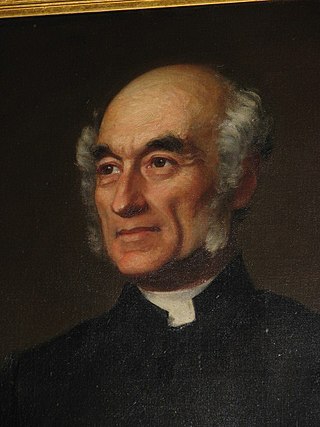
Whitwell Elwin was an English clergyman, critic and editor of the Quarterly Review.

Baden Powell, MA FRS FRGS was an English mathematician and Church of England priest. He held the Savilian Chair of Geometry at the University of Oxford from 1827 to 1860. Powell was a prominent liberal theologian who put forward advanced ideas about evolution.

Patrick Matthew was a Scottish grain merchant, fruit farmer, forester, and landowner, who contributed to the understanding of horticulture, silviculture, and agriculture in general, with a focus on maintaining the British navy and feeding new colonies. He published the basic concept of natural selection as a mechanism in evolutionary adaptation and speciation in 1831, but did not further develop or publicize his ideas. Consequently, when Charles Darwin later published On the Origin of Species in 1859, he and Alfred Russel Wallace were regarded by their scientific peers as having originated the theory of evolution by natural selection; it has been suggested that Darwin and/or Wallace had encountered Matthew's earlier work, but there is no hard evidence of this. After the publication of On the Origin of Species, Matthew contacted Darwin, who in subsequent editions of the book acknowledged that the principle of natural selection had been anticipated by Matthew's brief statement, mostly contained in the appendices and addendum of his 1831 book On Naval Timber and Arboriculture.

The publication of Darwin's theory brought into the open Charles Darwin's theory of evolution through natural selection, the culmination of more than twenty years of work.
The immediate reactions, from November 1859 to April 1861, to On the Origin of Species, the book in which Charles Darwin described evolution by natural selection, included international debate, though the heat of controversy was less than that over earlier works such as Vestiges of Creation. Darwin monitored the debate closely, cheering on Thomas Henry Huxley's battles with Richard Owen to remove clerical domination of the scientific establishment. While Darwin's illness kept him away from the public debates, he read eagerly about them and mustered support through correspondence.
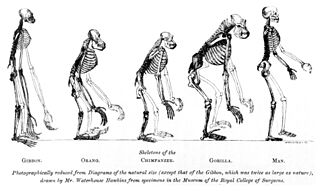
Evidence as to Man's Place in Nature is an 1863 book by Thomas Henry Huxley, in which he gives evidence for the evolution of humans and apes from a common ancestor. It was the first book devoted to the topic of human evolution, and discussed much of the anatomical and other evidence. Backed by this evidence, the book proposed to a wide readership that evolution applied as fully to man as to all other life.

Thomas Hornsey Bell FRS FLS was an English zoologist, dental surgeon and writer, born in Poole, Dorset, England.
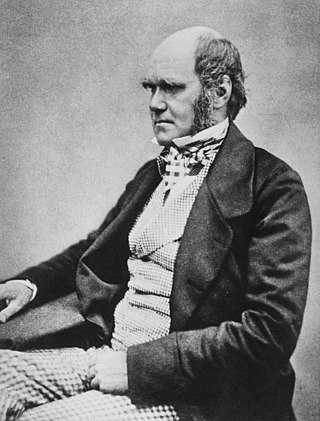
Charles Robert Darwin was an English naturalist, geologist and biologist, widely known for his contributions to evolutionary biology. His proposition that all species of life have descended from a common ancestor is now generally accepted and considered a fundamental concept in science. In a joint publication with Alfred Russel Wallace, he introduced his scientific theory that this branching pattern of evolution resulted from a process he called natural selection, in which the struggle for existence has a similar effect to the artificial selection involved in selective breeding. Darwin has been described as one of the most influential figures in human history and was honoured by burial in Westminster Abbey.
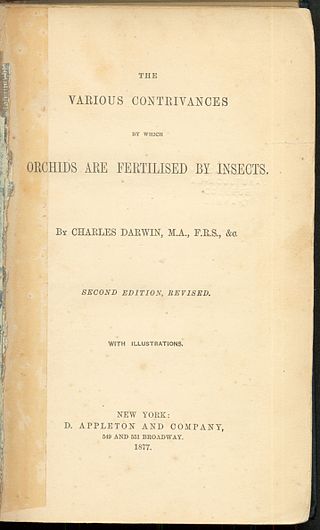
Fertilisation of Orchids is a book by English naturalist Charles Darwin published on 15 May 1862 under the full explanatory title On the Various Contrivances by Which British and Foreign Orchids Are Fertilised by Insects, and On the Good Effects of Intercrossing. Darwin's previous book, On the Origin of Species, had briefly mentioned evolutionary interactions between insects and the plants they fertilised, and this new idea was explored in detail. Field studies and practical scientific investigations that were initially a recreation for Darwin—a relief from the drudgery of writing—developed into enjoyable and challenging experiments. Aided in his work by his family, friends, and a wide circle of correspondents across Britain and worldwide, Darwin tapped into the contemporary vogue for growing exotic orchids.

Evolutionary thought, the recognition that species change over time and the perceived understanding of how such processes work, has roots in antiquity—in the ideas of the ancient Greeks, Romans, Chinese, Church Fathers as well as in medieval Islamic science. With the beginnings of modern biological taxonomy in the late 17th century, two opposed ideas influenced Western biological thinking: essentialism, the belief that every species has essential characteristics that are unalterable, a concept which had developed from medieval Aristotelian metaphysics, and that fit well with natural theology; and the development of the new anti-Aristotelian approach to modern science: as the Enlightenment progressed, evolutionary cosmology and the mechanical philosophy spread from the physical sciences to natural history. Naturalists began to focus on the variability of species; the emergence of palaeontology with the concept of extinction further undermined static views of nature. In the early 19th century prior to Darwinism, Jean-Baptiste Lamarck (1744–1829) proposed his theory of the transmutation of species, the first fully formed theory of evolution.
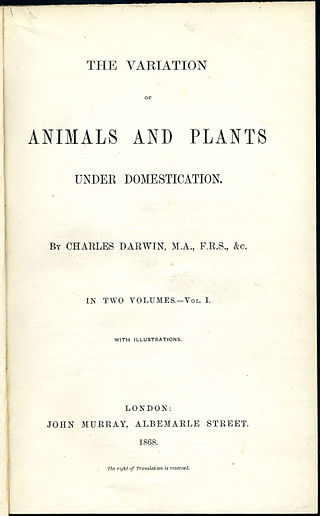
The Variation of Animals and Plants Under Domestication is a book by Charles Darwin that was first published in January 1868.

This bibliography of biology is a list of notable works, organized by subdiscipline, on the subject of biology.

On the Movements and Habits of Climbing Plants is a book by Charles Darwin first printed in book form in 1875 by John Murray. Originally, the text appeared as an essay in the 9th volume of the Journal of the Linnean Society, therefore the first edition in book form is actually called the ‘second edition, revised.’ Illustrations were drawn by Charles Darwin’s son, George Darwin.
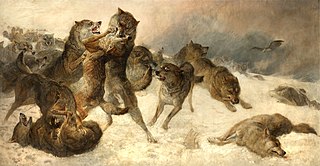
The concept of the struggle for existence concerns the competition or battle for resources needed to live. It can refer to human society, or to organisms in nature. The concept is ancient, and the term struggle for existence was in use by the end of the 18th century. From the 17th century onwards the concept was associated with a population exceeding resources, an issue shown starkly in Thomas Robert Malthus’ An Essay on the Principle of Population which drew on Benjamin Franklin's Observations Concerning the Increase of Mankind, Peopling of Countries, etc..

















